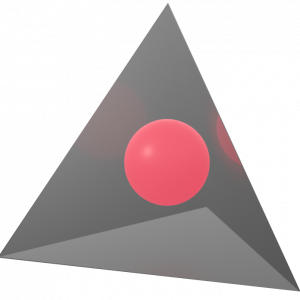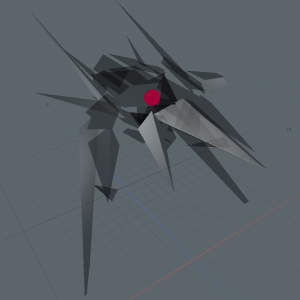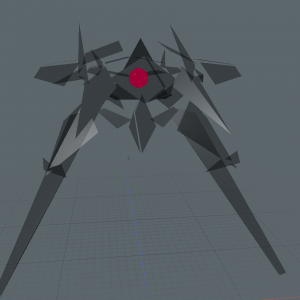Table of Contents
Polygons
| “A slice of the infinite; vivid transparency and muted rage” |
To attempt to define Polygons, their inner mechanisms, purpose or motives will surely be met with failure as it has done so many times. Instead, what is known of them rather than about them is documented - as best to prepare those who are to encounter them. Some believe them to be aliens, machines or interdimensional intelligence - others, a natural “part” of the universe. The truth is nobody knows and to this day, Polygons defy meaningful definition - with things fundamentally understood about them changing yearly.
Introduction
Polygons as they are called are commonly characterized by a shaped colored core at their center which seems to contain their more critical components - such as whatever energy source, thought or projection they are capable of. Their exterior forms, resembling low polygonal slices suspended in three dimensions are comprised of a thin layer of hard light and dimensional impaction - a cross-section of space-time. These many components move as a single object, though may be reconfigured into a variety of forms to exert differing forces - in much the same way transistors, resistors and cathodes are all made of the same quintessential ‘stuff’ but their arrangement creates different effect. These cross-sections which coin their name lens light in a variety of different ways, may assume color and even in some cases simple “low resolution” imagery. Struck, these forms give off ablative hardlight as blinding sparks, combustion and light and when destroyed, they appear to shatter into geometric shapes individually. It is known that to destroy a Polygon, the inner core must be destroyed - demanding that the different layers are destroyed.
Much of the way Polygons exert action comes down to electromagnetism and spacetime - compressing and expanding space for a variety of effects.
The actions of Polygons in battle seem to indicate they can assume a vast variety of forms which are approximations and copies of common objects (typically machines) — which they copy the inner systems and performance envelopes of with great accuracy. They typically attack quickly and in great number and then disappear as quickly as they had done so just before a battle is concluded. Their tactics are merciless, aiming to reduce and decimate numbers rapidly rather than striking high value targets — with a key interest in civilians and noncombatants.
Observation over time reveals their model of warfare seems to follow a fairly simple set of logical patterns, logic, equation and statistical assessment - and those experienced in dealing with them can often bait them into confrontations or with limited success avoid skirmishes or appear uninteresting to them.
What is known is that while they demonstrate remarkable capacity for replication, they are very very limited in creating and creativity — and cannot innovate.
Along with purely functional replicas, they are also known to create illusions and mirages through methods unknown which are incredibly convincing — using highly accurate replicas of real people which speak and act appropriately if “sampled” from a source material (which must be destroyed to create a successful replica). Limited encounters in these mirage-spaces reveals that while Polygons are very interested in other forms of life, they have a poor understanding of illogical thought and many fundamental ideas to us are entirely alien to them. While they are describable as a “flicker of infinity” by some, they are not all knowing and they are not in and of themselves infinite.
A number of these replicated individuals are known to appear several times. If these persons are sighted, it is expected that person, persons, personhood, union, legion or other should inform the governing body or law enforcement immediately.
Known Types
Type I (Patrol)
The most common type, 'Patrol' are known to move along set routes searching for new targets. Not particularly fast or well armed, they often move alone and are an easy indicator of Polygon territory. Importantly, should they spot a target, they signal to other types over great distances during which time it will attempt to defend itself while retreating. Usually, there are only a few minutes between a Patrol calling for aid and other types arriving.
Patrol typically only occupy pre-existing Polygon territory.
Type II (Fight)
The primary response to a Patrol spotting a target, Fight are very agile space or airborne classifications designed for combat. They demonstrate fairly low intelligence, depending on a leader sub-type to coordinate their attacks as a group. When the leader is destroyed, their behavior typically falls into disarray.
Type III (Disrupt)
The first discovered of the support-classes, Disrupt exist to disrupt electromagnetic and subspace communications and during operation, most forms of faster-than-light travel are unavailable. They are far less mobile than their combat oriented counterparts and typically have their own wing of Fight to support and defend them – though they are sometimes known to hide.
Type IV (Roam)
A hated sight, Roam serve as a recognisance unit. They are known to test heavily defended areas automatically even at their own enormous detriment and are near suicidal in this behavior. That being said, they have remarkable durability and offensive capability and typically travel in pairs long distances from other Polygons.
Type V (Surface)
Something of a misnomer, Surface is the first type to replicate characteristics from another platform - specifically transformable fighters. They excel at high mobility combat and surgical strikes and are particularly dangerous for permanent installations and large platforms. They are a near perfect replica, right down to size and proportion, being scarcely larger than most high mobility frames – usually less than four or five meters.
Their name comes from their capacity to hug terrain and skim above the ground at high speed, a characteristic only incorporated into later transformable fighters. By hiding and taking non-line-of-sight potshots over the curvature of a planetoid, they could in this sense also be deployed for defensive purposes to hold territory. Those that do so long enough become Walkers.
Type VI (Walk)
Based on the Ourex surface to orbit defensive strike walkers of the old war, Walkers are designed to hit almost any point on a planetoid using a magnetically accelerated cannon to fire positron beams over enormous distances through laser created vacuum tunnels. Their mode of operation has them hiding behind electromagnetically absorbant particle scattering between strikes to prevent oncoming hits often hiding near enemy targets of high value to maximize collatoral. This is a far-cry from the nuclear defensive arsenal of the Ourex which used positron slug warheads with artificially intelligent detonation matrixes and a nuclear solution to the stealth problem which when detonated in the upper atmosphere cast an electromagnetic pulse so intense that it could mask its position from orbit.
Type VII (Defend)
Defend is the first classification of dynamic polygon. Typically an octahedron, the Defend arranges its constituent parts in different ways allowing its core to serve as an advanced heavy positron weapon. Unlike the Walk, the damage potential for the Defend is much greater and it is able to orient and alter space to form incredible defensive fields. Each shot and the topology of the Defend is bespoke based on its target and required output. It is also the first classification of Polygon with a three dimensional shadow and a two dimensional body - with its shadow being its “true body”. The Defend has a natural lift ceiling of 100 meters from any given surface and cannot be formed without a place to cast its shadow that is not also Polygon controlled.
OOC
The mind has to make sense of something, if it can't, it terrifies us. To understand the dialogue, I'm sure the mind would interpret it as awkward conversation.
We invent context when there is no context and we convince ourselves that we know whats happening even when we don't, for our own sake and the sake of ourselves whom without this couldn't be. Concepts like these make the core of cosmic horror. I can see them being very interested in our need to find meaning. If they are slithers of infinity, we are the finders of meaning – and 'meaning' is as abstract to them as they are to us.


